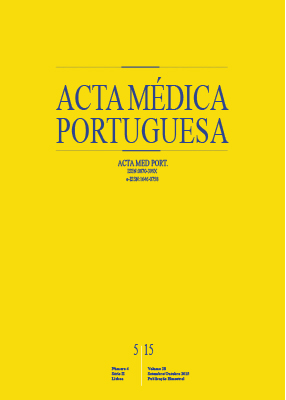Streptococcus pneumoniae Vaccination in Children and Adolescents at High Risk of Invasive Pneumococcal Disease
DOI:
https://doi.org/10.20344/amp.6545Keywords:
Adolescent, Child, Pneumococcal Vaccines, Streptococcus pneumoniae, Vaccination.Abstract
Background: In Portugal, pneumococcal vaccination is free of charge and recommended by the Directorate-General of Health for the pediatric population at high risk of invasive pneumococcal disease. Our main aim was to describe the vaccination uptake in a pediatric population attending a hospital outpatient clinic.
Material and Methods: Cross-sectional observational survey of a pediatric population attending a referral hospital outpatient clinic, from July to December 2014. Data was collected from clinical records, Individual Health Bulletin or the registry from Plataforma de Dados da Saúde®.
Results: Of the 122 participants, 95.9% had, at least, one shot of pneumococcal vaccine, but only 64.8% of these completed the age recommended vaccination scheme. Uptake was higher in children < 5 years old. The proportion of complete vaccination schemes was 100% in hemoglobinopathies and human immunodeficiency virus infection groups, 66.7% in prematures, 62.5% in splenectomized and 54.7% in Down syndrome. Children had better complete vaccination schemes when they attended the Pediatric Infectious Disease (100%) and Pulmonology Clinics (88.2%). Children > 5 years old had a higher uptake of 23-valent polysaccharide vaccine than the 2 to 5-years old ones (74.5% vs 40.5%; p < 0.001).
Discussion: Most of our pediatric population at high risk of IPD was vaccinated; nevertheless, only two-thirds had completed the scheme for their age. The main failure was on the 23-valent polysaccharide vaccine administration.
Conclusions: Although these results are better than those reported in other European countries with similar recommendations, it is essential to explore the causes for the observed flaws in order to optimize vaccination rates.
Downloads
Downloads
Published
How to Cite
Issue
Section
License
All the articles published in the AMP are open access and comply with the requirements of funding agencies or academic institutions. The AMP is governed by the terms of the Creative Commons ‘Attribution – Non-Commercial Use - (CC-BY-NC)’ license, regarding the use by third parties.
It is the author’s responsibility to obtain approval for the reproduction of figures, tables, etc. from other publications.
Upon acceptance of an article for publication, the authors will be asked to complete the ICMJE “Copyright Liability and Copyright Sharing Statement “(http://www.actamedicaportuguesa.com/info/AMP-NormasPublicacao.pdf) and the “Declaration of Potential Conflicts of Interest” (http:// www.icmje.org/conflicts-of-interest). An e-mail will be sent to the corresponding author to acknowledge receipt of the manuscript.
After publication, the authors are authorised to make their articles available in repositories of their institutions of origin, as long as they always mention where they were published and according to the Creative Commons license.









